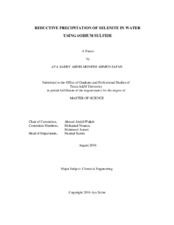| dc.description.abstract | Selenium (Se) is an essential trace element to humans and animals due to its function as an antioxidant and catalyst for the production of active thyroid hormone. However, it is toxic at high concentrations, which can cause diseases and death to humans. Selenium is released to the environment from sewage sludge and industrial facilities such as mining, oil and gas processing, power generation, coal combustion, metals and petrochemical industries. Selenium removal from contaminated wastewaters is necessary due to its toxicity and potential harm to human health and the environment. Selenium can be removed from wastewaters using biological or chemical/physical processes. However, each of these processes has its own limitation. For example, biological treatment of selenium requires several hours of hydraulic residence time and chemical/physical processes either produces unstable selenium-bearing residuals or concentrated liquid waste byproduct.
Reductive precipitation of selenium is an attractive process because it can convert the soluble forms of selenite and selenate to insoluble elemental selenium. This study investigates selenite (Se(IV)) removal from water via reductive precipitation using sodium sulfide at neutral pH. Also, this study investigates the effect of UV light irradiation as an activation method to enhance Se(IV) reduction.
Analysis of precipitated solids using XPS, SEM, and XRD indicated that Se(IV) was reduced to elemental Se or solids composing of Se and sulfur (S) (e.g. SenS8-n). High-resolution S 2p spectra suggested the presence of sulfur oxyanions, monosulfide (S^2-), polysulfides (Sn^2-), and elemental sulfur. SEM images showed large irregular aggregates that were dominant at acidic pH than neutral pH, and they were more noticeable in the presence of UV light. Additionally, it was observed from XRD patterns that elemental selenium (layered plate shape) was dominant in the absence of UV light. Whereas, cyclic Se-S precipitates (Se3S5) with orange color were dominant in the presence of UV light.
Selenite was effectively removed at neutral pH, regardless of the presence of UV light. UV light did not enhance Se(IV) removal at tested conditions, but it affected the solid morphology and its composition. Complete removal of selenite was achieved in less than five minutes at sulfide dose to initial Se(IV) molar ratios above 11.5. | en |


